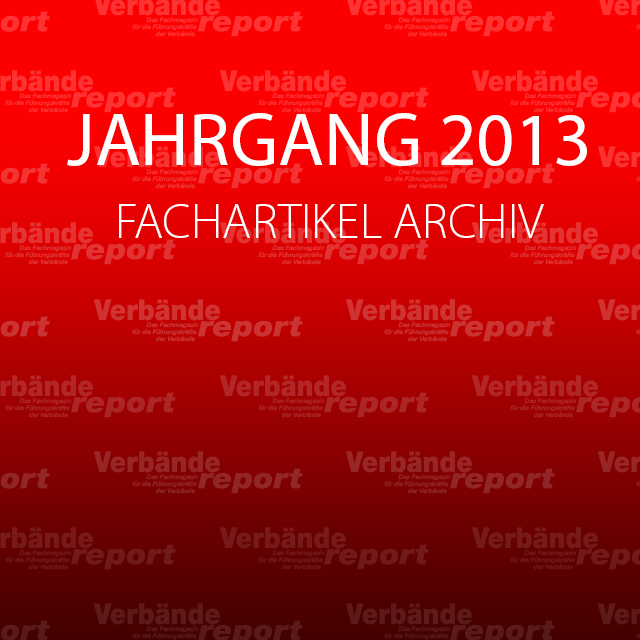Zunehmend interessant sind mobile Anwendungen auf Smartphone auch für Verbände: dort werden Informationen zur Recherche bereitgestellt oder Kongresse und Messen vor- und nachbereitet. Vom Standplan über die Agenda bis hin zur Einsicht in die Tagungsunterlagen ist vieles denkbar. Doch schrecken die doch hohen Investitionskosten von mehreren tausend Euro ab. Dabei können auch Verbände nicht hoffen, dass die Investition sich rentiert, wenn auf die Nutzer nur gewartet wird. Der Artikel stellt Strategien und Ideen vor, wie sich die Vorteile von Mobile-Apps in der Kommunikation von Verbänden wiederfinden und welchen Nutzer Mitglieder daraus ziehen können.

According to the mobile application analytics
company Flurry, 2011 holiday season might have been the tipping point that associations have been waiting for to see whether mobile apps are catching on. The company reported in January that more than 20 million iOS and Android electronic devices were activated during the week of December 25, with more than 6.8 million on Christmas day alone.
What’s more, the balance of mobile app use versus web browsing has shifted among smartphone users. Since last June, Flurry reports, the average smartphone user spends more minutes per day accessing mobile apps than surfing the web (72 daily web minutes versus 94 minutes with apps in December 2011).
Statistics like these are causing associations to take notice and examine the idea of creating mobile apps, which can
range from $3,000 to $5,000 for an off-the-shelf product to $25,000 to $45,000 for a custom solution. But the looming questions remain: How can associations pay for mobile apps? And more important, how can they use them to generate nondues revenue?
Green Savings and Advertising Sales
The lowest-hanging fruit in the association mobile app world are apps for annual conferences or other highly attended events. And one of the most basic ways to monetize an app is to save money by switching from printed packets of conference information to providing it in an app, says Darryl Walter, director of membership marketing and conferences for The Wildlife Society.
TWS’s annual conference draws about 1,400 attendees, and last year it replaced its 120-page printed conference pocket guide with a mobile app and a modified printed conference book. Walter says the cost of the app was less than printing the pocket guides. “As we and other associations attempt to ‘green’ conferences, apps are significant in reducing the number of print materials needed,” he says.
The print-and-app mix can also be the key to monetizing an app using advertising revenue, says Cam Bishop, CEO of Ascend Integrated Media, which has been creating event-oriented mobile apps for about three years. “In the early days when we would add mobile solutions, it was almost impossible to sell real estate such as banners and buttons on a mobile app,” Bishop says. As apps for conferences become more common, “we’re seeing less resistance and more acceptance of advertising from people who exhibit at tradeshows.”
Bishop says he sees success when
organizations bundle mobile advertising opportunities with more traditional sponsorship offerings. That’s how Beth Hecquet, CMP, director of meetings and events for the National Association of Sports Commissions, helps cover the cost of her organization’s app, which is $5,000 a year with a two-year contract. NASC developed an event app to cut down on printing costs—including the $1,000 fee for printed copies of the attendee registration list—and to give its event a more high-tech, modern feel.
NASC sells a sponsorship for the conference app but creates other conference sponsor packages offering recognition in both the conference program and the mobile app. “I do not have the time to sell and fulfill a whole lot of little sales, so instead [I] add value to existing packages for sponsors and exhibitors via exposure on the app,” Hecquet says.
The Society of Actuaries is in the process of growing its market for advertising and sponsorship, says Professional Development Manager Kerri Leo, CAE. SOA has used mobile apps for three events and has plans for four more this year. The first app cost $10,000 to develop. New features and functionality will significantly increase future costs, she says, but the experiment is well worth it even though SOA has not been able to recoup costs in advertising revenue yet.
“Our members love it,” she says. “They absolutely love it. They keep asking, ‘Can you do this with it?’ and ‘Can you do that with it?’” SOA’s app includes polling, session evaluations, and its most popular feature: an integrated tracking system that monitors session lengths to record how many continuing-education credits attendees can claim.
Leo says the mobile app platform can integrate banner ads into a launch screen and on top of every page. Each time attendees check the schedule or download handouts, they’re seeing an ad, she says. “We’ve sold a few banner ads, but I wouldn’t say we’re breaking even yet,” Leo says. “As this grows and people see the potential, I definitely think we’ll be able to generate revenue.”
Tim Moberly, SOA’s director of technology services, says it will add questions on 2012 meeting registrations to ask attendees if they want printed copies of conference materials. “If not, we’re going to cut down on print to recoup costs,” he says. But Moberly says that mobile conference apps are just one part of a series of mobile initiatives that his organization has adopted for 2012 and beyond, and its focus for all apps is more about serving the profession than monetization.
Alex Mouw, senior consultant for web solution strategy for Results Direct, says her company is seeing a resurgence of advertising in associations in general and an increase in digital advertising in particular. “Years ago, everyone was advertising, and members got annoyed. A lot of associations took a big step back,” she says. But now that mobile solutions allow advertising to be designed into the graphics and can analyze content to make ads more relevant, more associations are adopting advertising into their mobile-app monetization strategy.
The Society of Cable Telecommunications Engineers has its own monetization success story. One of the reasons it launched apps for four of its events, including the 10,000-attendee SCTE Cable-Tec Expo, was that its members wanted the organization to cut down on paper use.
“Members were specifically asking, ‘Where’s the app?’” says Bill Schankel, senior director of marketing. Attendees wanted a more interactive conference experience, he says, and SCTE staff wanted to give life to their events beyond the onsite time.
Schankel says SCTE started the appdevelopment process knowing that it needed to generate revenue to at least cover creation costs, which run at approximately $8,000 for its biggest show and about $2,000 for each of its three other events. The Cable-Tec Expo’s app includes the event’s schedule, floor plan, and event highlights. In addition, attendees can post profiles and search for other attendees. SCTE is adding online scavenger hunts and other interactive features this year.
SCTE sells ads as well as enhanced listings in the mobile exhibitor directory. Exhibitors can tie into social media by putting their Twitter feeds into the app, and they can market themselves with alerts and push notifications. The association has also secured sponsorship for all four apps it plans to launch in 2012. “A lot of our exhibitors and sponsors are very happy because the functionality of the apps really matches up to their marketing goals. We offset our costs and have created a nondues revenue source as well,” says Schankel.
Paying for Content
Another monetization strategy, says Mouw, is a paid app that showcases technical content created by the association. “So far we’re not seeing too many associations go down that path, but there are several in the medical space,” she says. For example, the Heart Rhythm Society sells an iPad app for $3.99 that allows doctors to show patients videos and graphics of heart problems. And the American Heart Association sells its “Pocket First Aid and CPR” app for the same price.
“If an app has a price, it has a higher perceived value,” Mouw says.
The Marble Institute of America is counting on that to be true. Gary Distelhorst, CAE, executive vice president and CEO, says MIA is launching a new paid app that it hopes will appeal to designers and architects, most of whom have adopted tablet devices and smartphones as business tools.
The app is a digital version of one of its bestsellers, a line of books imported from Italy with images of stone from all over the world. The book sells for $89, and the app version will sell for $14.99. MIA invested $16,000 in the app’s development and will earn half the proceeds from the sales.
“We really don’t need to sell too many to get our money back. We’ll have to see if it works,” Distelhorst says. “Selling a couple of thousand of those around the world, I think, is very doable.”
Another app in development will showcase North American stone. The idea, Distelhorst says, came from a poster called “Stones of North America” that the association sells to members to use in their showrooms. The app will include full-screen images of the stones, technical data, and pictures of projects that feature the stone. In addition, the app includes an interactive locator so that architects can see where the quarries are in relation to their projects.
The $17,000 development costs were covered by a sponsor, and each quarry pays to have each stone included, with 70 stones so far. Architects can download the app for free. To try and drum up an interest in its new apps, Distelhorst says MIA is promoting them in design journals and at tradeshows.
Put Members First
No matter how associations choose to step into mobile monetization, it is no surprise that experts agree that the key to making money is to give buyers what they want. More Flurry Analytics reports reveal that apps focused on games and social networking consume almost 80 percent of users’ mobile app activity, with entertainment and news garnering another 13 percent of users’ time. That leaves just 8 percent for “other” apps, a category under which many mobile apps produced by associations could fall.
“People have a lot of apps on their phone. It’s competitive real estate. Organizations sometimes develop the one-hit wonder for an event—it’s helpful once but then gets deleted,” Mouw says. “Developing an app strategy is really not so different than developing any other strategy in an organization. It really needs to be goal-driven.”
Aside from making sure the functionality is user-friendly and goalbased before you create an app, Mouw says, associations cannot rely on an “if you build it, they will come” strategy to promote it. Walter says TWS’s app was not ready until a month before the conference. The organization promoted the app be-fore the event and then onsite, but “the response from many was that they didn’t know we had an app,” says Walter.
“A lot of associations miss out on the marketing part because they are shy about talking about their own things. You can’t just put it in the store and hope people will discover it,” says Mouw. She says associations should create a cross-platform advertising strategy that includes advertising in publications and reaching out to their most vocal members and offering them a sneak peek of your new tool.
“Let them talk about it. Let them build a buzz about it,” Mouw says. “Associations need to let members and attendees know that this is a wonderful thing that we’re doing for you because you’re important.”



